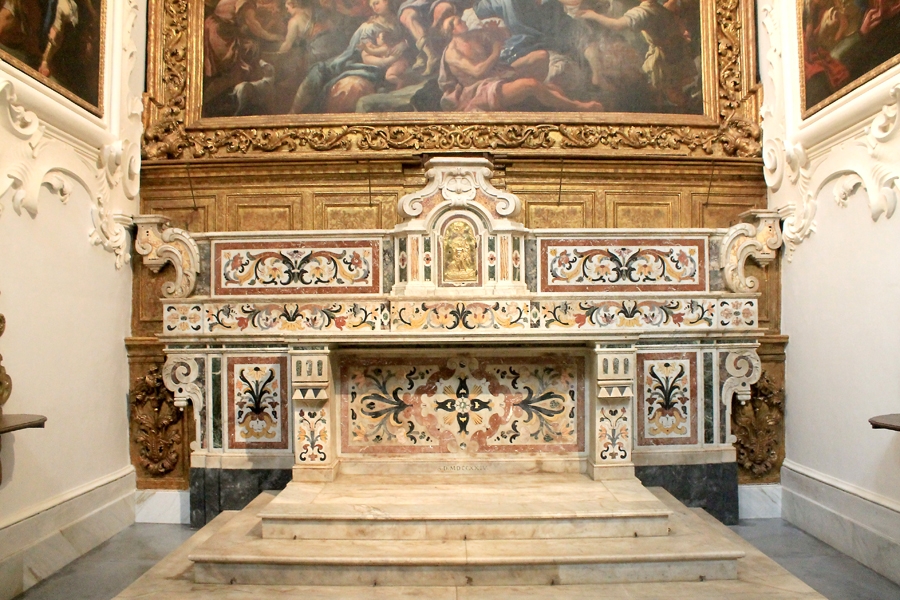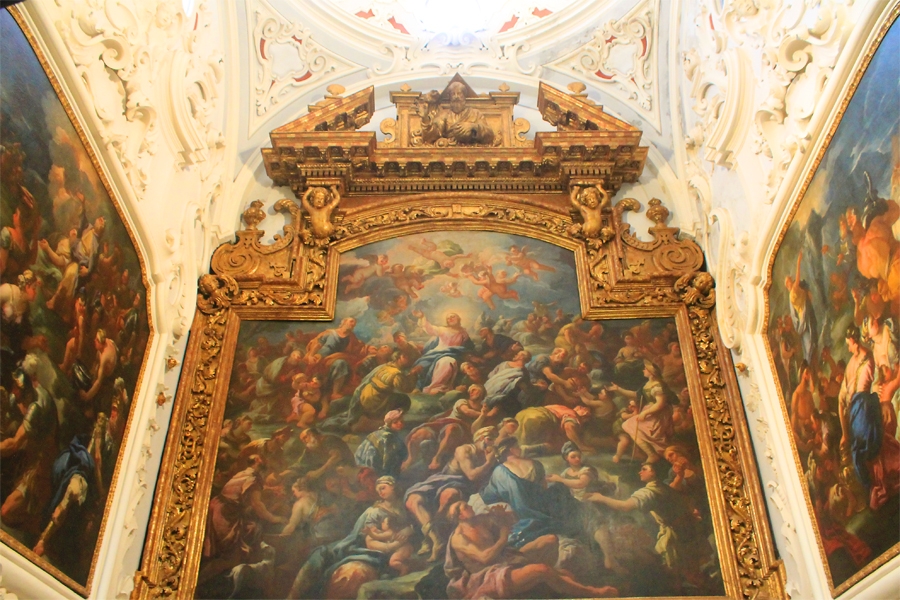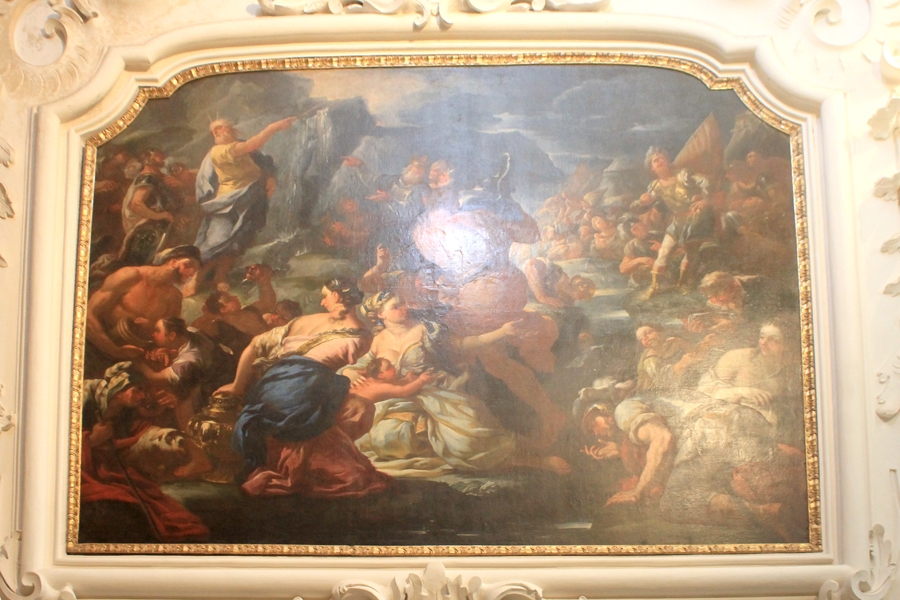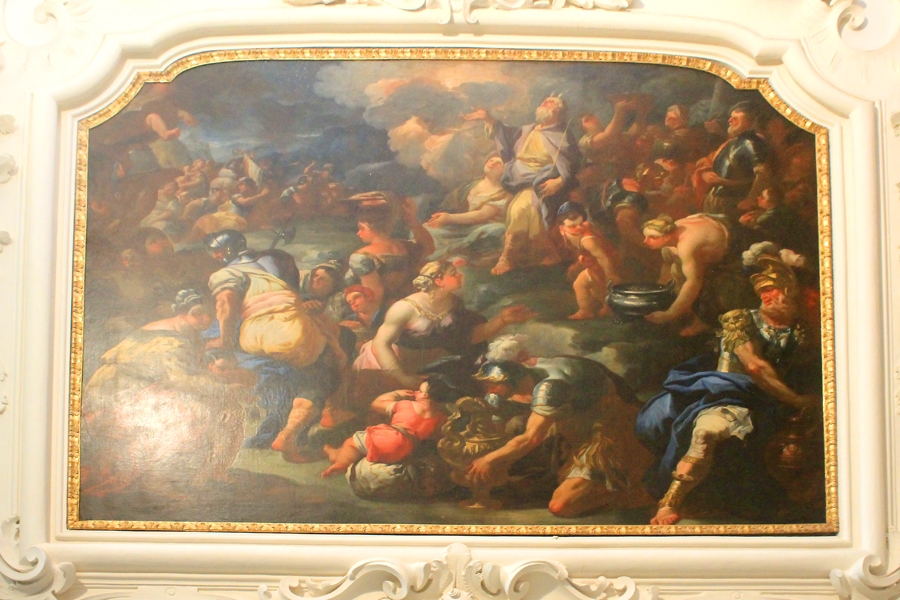

Chapel of the Blessed Sacrament
The Chapel is delimited by an elegant and artistic wrought iron gate with floral motif studs in bronze in compliance with a Papal Decree of 1653, concerning collegiate churches, as the Church of San Pietro was classified at that time, the Chapel is presented with precious inlaid polychrome marbles for the altar and the balustrade, embellished with stuccoes and richly framed canvases. It has a domed vault, resting on pendentives and veined with a dense texture of stuccoes that also cover the rest of the spans. It is the only one of the chapels to have a domed vault.
The large altar, with shelves, interwoven with elegant floral motifs on a white background, is a work that dates back to 1724 and was created by the well-known master of the Neapolitan artistic school Andrea Raguzzino.
The three canvases inside, depict biblical episodes, prefigurations of the Eucharistic presence, and precisely: "The multiplication of the loaves", the largest, placed in the center of the chapel, "The fall of the manna", on the right, "Moses who makes the water gush from the cliff », on the left. These canvases are admired for the large number of well-constructed characters rich in pictorial substance, who move, or recline, with ease in a vast and harmonious space not devoid of naturalistic annotations. Although lacking a signature, they are attributed for stylistic characteristics to Andrea Miglionico, student artist of the school of Luca Giordano, born in Cilento in 1663 and active in Puglia from 1706 to 1711. Miglionico painted these works, more than in the last phase of his Apulian activity, in Naples, where he returned and died there in 1718.
In "Moses who makes water flow from the cliff" (Exodus, chap. XVII), the emblematic group of two opulent women with wide necklines, with bodies juxtaposed and contrasted in a chiasmus; or the academic figure of the one who advances, behind them diagonally to the scene, with a plastic bust rotating in an effort to keep on his right shoulder a precious and capable vase outlined by the grazing light; or again, the military man with luminous reflections on the helmet and armor, all bent to bring his lips closer to the running water, made by Moses from the rock of Horeb, in the desert locality from that moment called Massa and Meriba, precisely because of the riot of the Jews because of the thirst they suffered.
In the painting of "The Fall of the Manna" (Exodus, chap. XVI) the scene does not differ much. At the miracle placed by Moses, depicted above in the act of praying with his head turned to the sky, the joyful people bend down to collect the divine gift using precious and highlighted crockery. The many unsharp figures on the background are contrasted by figures in the foreground, firmly built and differently posed, such as that of the soldier, or the other from behind, on the left, sitting on a spike of rock covered by a blue mantle, in tension of rotation.
In the central canvas, "The multiplication of the loaves", the closest, according to various interpretations, to "The apotheosis of S. Teresa" (Church of S. Teresa dei Maschi di Bari), the numerous bystanders (Apostles and followers), intent on satisfying their hunger with miraculously multiplied bread and fish, they arrange themselves, with the grandeur of their bodies, in a large rotating movement around the figure of Christ who radiates light expanding over a large portion of the sky in which winged angels whirl freely .
Above the central pictorial work, with a gilded frame and decorated with a continuous festoon of leaves in relief, rest two little angels supporting a broken wooden tympanum, in the center of which the figure of the Eternal Father blessing stands out.
 This website project born from the idea of Gianni Musaio is enclosed in a team spirit and is the result of the collaboration of people, ordinary citizens, who care about the historical, cultural, artistic, geographical, food and wine heritage of the historic center of Putignano, a town in to live.
This website project born from the idea of Gianni Musaio is enclosed in a team spirit and is the result of the collaboration of people, ordinary citizens, who care about the historical, cultural, artistic, geographical, food and wine heritage of the historic center of Putignano, a town in to live.

The historic center of a town is the fulcrum of the territory, where ancient stories, traditions and culture of those who preceded us are preserved. You too can contribute to leaving the testimonies of the past to the generations to come, taking care of them.






